Flamingo facts for kids? Flamingos are one of the most instantly recognizable birds in the world due to their unique pink plumage, long legs, and social behavior. But what is the speciality of flamingo that captures the imagination of both scientists and bird enthusiasts alike? The answer lies in a complex combination of biological traits, behaviors, and adaptations that are both fascinating and unique in the avian world. From their unusual feeding techniques to their symbolic presence in various cultures, flamingos continue to amaze us.
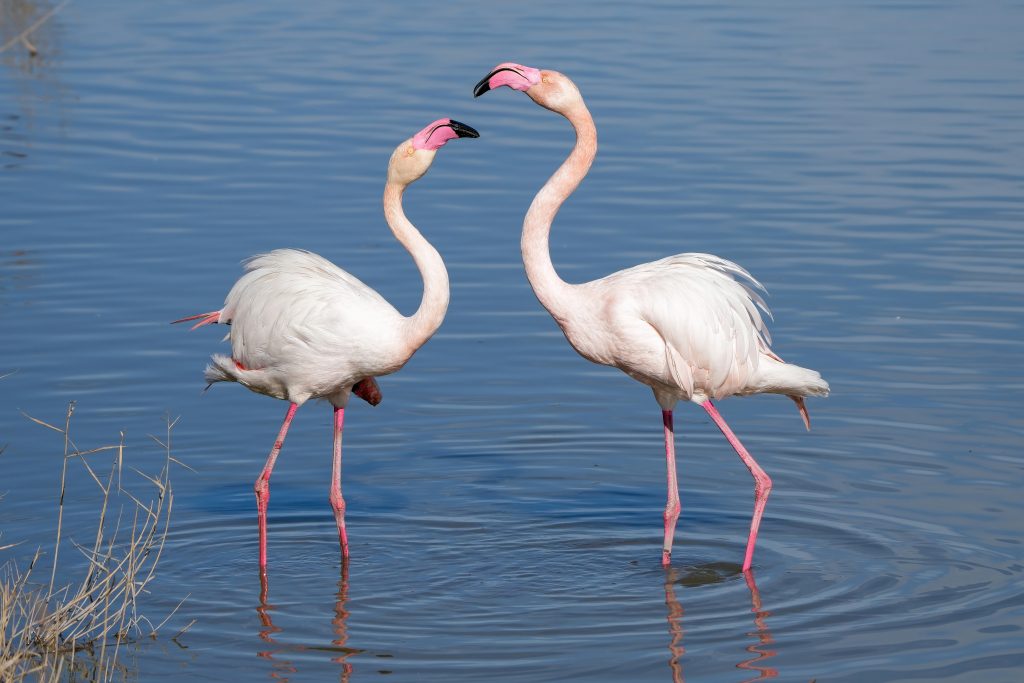
Flamingos belong to the family Phoenicopteridae and are known for inhabiting regions that are often too harsh for many other animals. They can be found in saline lagoons, alkaline lakes, and even coastal mudflats. These habitats contribute to their remarkable adaptations, including a filter-feeding mechanism aided by specialized structures in their bills called lamellae. The pink coloration of flamingos is another standout feature and is due to their diet, rich in carotenoid pigments found in algae and crustaceans.
Beyond physical traits, the flamingo’s social and reproductive behaviors also highlight their uniqueness. They form large colonies that can number in the thousands, engage in synchronized mating dances, and show dedicated parental care. Understanding what makes flamingos so special offers insights into evolutionary biology, ecology, and even cultural symbolism.
Key Takeaways
- Flamingos are uniquely adapted to live in saline and alkaline water bodies.
- Their pink color comes from carotenoid pigments in their diet.
- Filter-feeding using lamellae is a distinctive feeding behavior.
- Flamingos have intricate mating rituals and form massive colonies.
- Found in regions like Africa, the Caribbean, South America, and India.
- Includes six main species: Greater, Lesser, American, Chilean, Andean, and James’s Flamingos.
- Cultural and spiritual symbols in many societies.
- Conservation efforts are ongoing, supported by WWF and other organizations.
Flamingo Bird Facts: What Kind of Bird is a Flamingo?
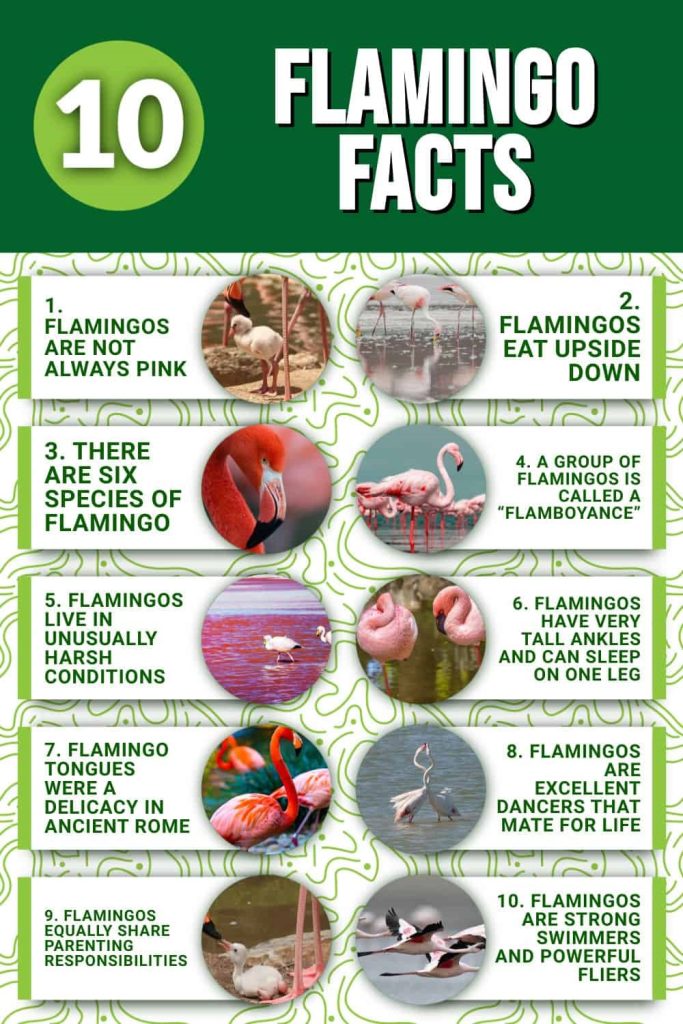
Flamingos are large wading birds classified under the order Phoenicopteriformes and family Phoenicopteridae. They are most well-known for their vibrant pink feathers, long necks, and equally long, slender legs. But what kind of bird is a flamingo, biologically speaking? They are filter-feeding specialists, adapted to thrive in environments that few other birds can tolerate. Flamingos can be found in saline and alkaline lakes, coastal lagoons, and mudflats across multiple continents.
Flamingos stand out not just in appearance but in their feeding mechanisms and social behavior. They are social birds, often seen in colonies that can number tens of thousands. Their communal lifestyle aids in protection from predators and is essential during breeding seasons. Their diet primarily consists of blue-green algae, diatoms, and small crustaceans, which are rich in carotenoids—compounds responsible for their pink to reddish coloration.
| Feature | Detail |
|---|---|
| Order | Phoenicopteriformes |
| Family | Phoenicopteridae |
| Habitat | Alkaline lakes, saline lagoons, mudflats |
| Diet | Algae, crustaceans, diatoms |
| Feeding Method | Filter feeding using lamellae |
| Notable Trait | Pink coloration from carotenoids |
| Social Structure | Large colonies for breeding and protection |
Flamingo Habitat Facts: Where Do Flamingos Live?
Flamingos are distributed across multiple continents, including Africa, South America, the Caribbean, Asia, and even parts of Europe. Their preferred habitats are often extreme, featuring high salinity or alkalinity that few other species can endure. Such habitats include saline lakes, alkaline lakes, coastal estuaries, salt flats, and lagoons. These unique ecosystems not only protect flamingos from predators but also provide abundant food sources such as algae and small invertebrates.
Some iconic flamingo habitats include Lake Bogoria and Lake Natron in East Africa, where large colonies of Lesser Flamingos gather. In the Caribbean, American Flamingos are commonly found in the salt flats of Bonaire and the Yucatán Peninsula. Andean Flamingos inhabit the high-altitude salt lakes of the Andes Mountains. These habitats play a vital role in the birds’ survival, breeding, and feeding.
Human activities, including mining, pollution, and tourism, have increasingly impacted these sensitive ecosystems. Conservation organizations like the WWF and local governments have started initiatives to protect these habitats. Understanding flamingo habitat facts helps us appreciate the environmental balance required for these birds to thrive.
| Region | Habitat Type | Flamingo Species Found |
| East Africa | Alkaline lakes | Lesser Flamingo |
| South America | High-altitude salt lakes | Andean, James’s Flamingo |
| Caribbean | Coastal lagoons, salt flats | American Flamingo |
| South Asia | Salt pans, wetlands | Greater Flamingo |
| Europe (Southern) | Coastal lagoons | Greater Flamingo |
Flamingo Diet: What Do Flamingos Eat and Why Are They Pink?
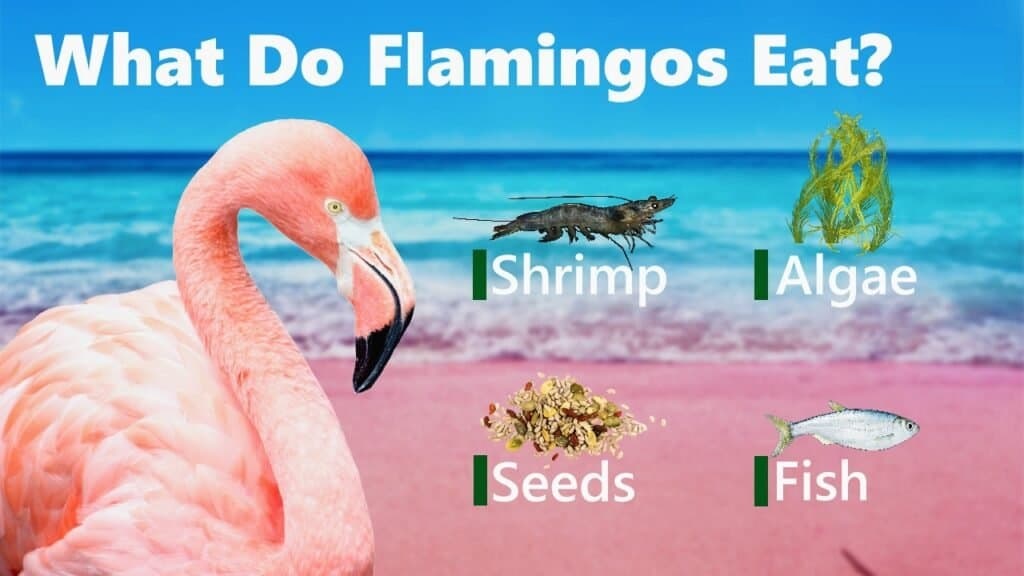
One of the most intriguing aspects of flamingos is their unique coloration and its direct connection to their diet. So, what do flamingos eat, and why are they pink? Flamingos primarily consume blue-green algae, diatoms, and small aquatic crustaceans such as brine shrimp. These food sources are rich in carotenoid pigments, particularly beta-carotene and canthaxanthin, which are metabolized and deposited in the flamingos’ feathers, skin, and beaks, giving them their signature pink to reddish hue.
Flamingos use a filter-feeding technique to gather food from muddy water. Their specially adapted bills contain comb-like structures called lamellae that sift through water to trap microscopic food particles. This feeding mechanism is a remarkable evolutionary adaptation allowing flamingos to extract nutrients from nutrient-rich, yet otherwise inhospitable, environments.
Chicks and juvenile flamingos are gray or white in color, gradually turning pink as their diet becomes rich in carotenoids. Captive flamingos may lose their color if not fed a diet rich in these pigments. Hence, their coloration is not just a cosmetic feature but a sign of dietary health and vitality.
| Diet Component | Function / Benefit | Source Location |
| Blue-green algae | Carotenoid-rich pigment source | Alkaline lakes |
| Brine shrimp | Protein and carotenoids | Saline water bodies |
| Diatoms | Source of silica and nutrients | Wetlands and salt pans |
| Carotenoid pigments | Responsible for pink feather coloration | Algae and crustaceans |
| Lamellae structures | Help in filter-feeding | Inside flamingo bills |
Flamingo Mating Dance: Courtship Rituals and Love Facts
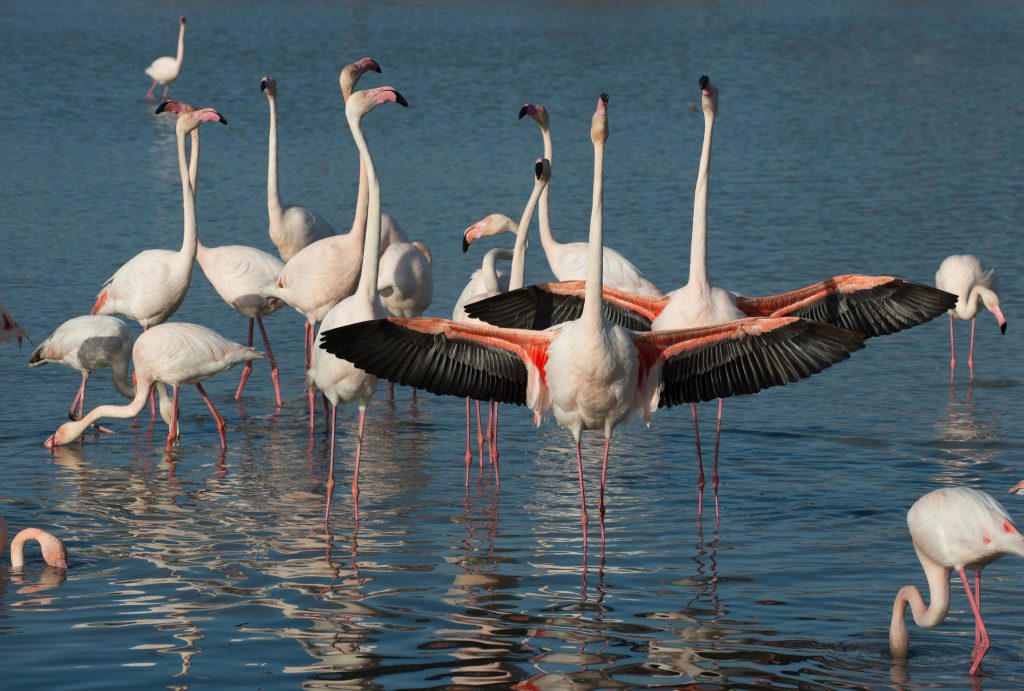
Flamingos are famous not only for their color but also for their elaborate courtship displays known as the flamingo mating dance. These dances involve synchronized movements, head-flagging, wing salutes, and collective marching. These behaviors strengthen bonds and signal readiness to mate. Flamingo love facts reveal a surprising level of coordination and teamwork, essential for reproduction in large colonies.
During the mating season, thousands of flamingos may participate in these rituals. Males and females both engage in the dance, and successful pairing is often determined by the enthusiasm and synchronization shown. These dances not only aid in mate selection but also stimulate hormonal readiness in the flock.
Once a pair bonds, they stay together for the season and engage in joint nesting efforts. This cooperative approach ensures the highest chance of successful chick rearing. Such behaviors reflect a deep-rooted evolutionary adaptation for species that depend heavily on colony-wide breeding success.
| Behavior | Purpose | Notes |
| Head-flagging | Attracts mates by showing neck movement | Involves rapid side-to-side head turns |
| Wing salutes | Shows off plumage and health | Flash of black flight feathers |
| Marching | Synchronizes movement in large groups | Builds social cohesion in colonies |
| Vocal calls | Reinforces bonding and recognition | Unique to pairs and colonies |
Baby Flamingo Facts: From Hatchling to Juvenile
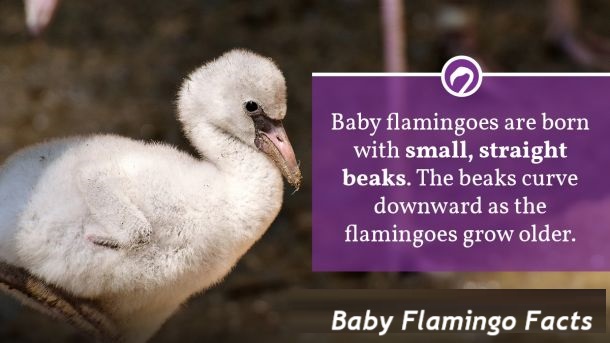
Baby flamingos, known as chicks, start life looking very different from the adults. When flamingo chicks hatch, they are covered in gray or white down and have straight, short beaks. Over the course of several weeks, their beaks curve and adapt for filter-feeding. One of the most interesting baby flamingo facts is that they rely entirely on their parents for food, receiving a substance called “crop milk,” which is rich in fat and protein.
Both the mother and father produce this crop milk in their upper digestive tracts. It contains carotenoids, which slowly begin the process of pigmentation. Flamingo chicks form “crèches,” or large groups of young birds watched over by a few adults, which offers safety in numbers. Over time, they begin foraging and feeding independently, and their feathers begin turning pink as carotenoids accumulate in their bodies.
These early life stages are crucial and susceptible to predation and environmental changes. Human disturbances, flooding, and food scarcity can impact chick survival. Conservationists often monitor nesting sites to ensure higher success rates for flamingo chick development.
| Feature | Baby Flamingo (Chick) Details |
|---|---|
| Appearance | Gray/white down, straight beak |
| Food Source | Crop milk from both parents |
| Diet Transition | Starts foraging around 2-3 weeks |
| Group Behavior | Forms crèches with other chicks |
| Color Change | Begins turning pink from carotenoids |
| Vulnerabilities | Predation, environmental disruptions |
Flamingo Nesting: How Flamingos Raise Their Young
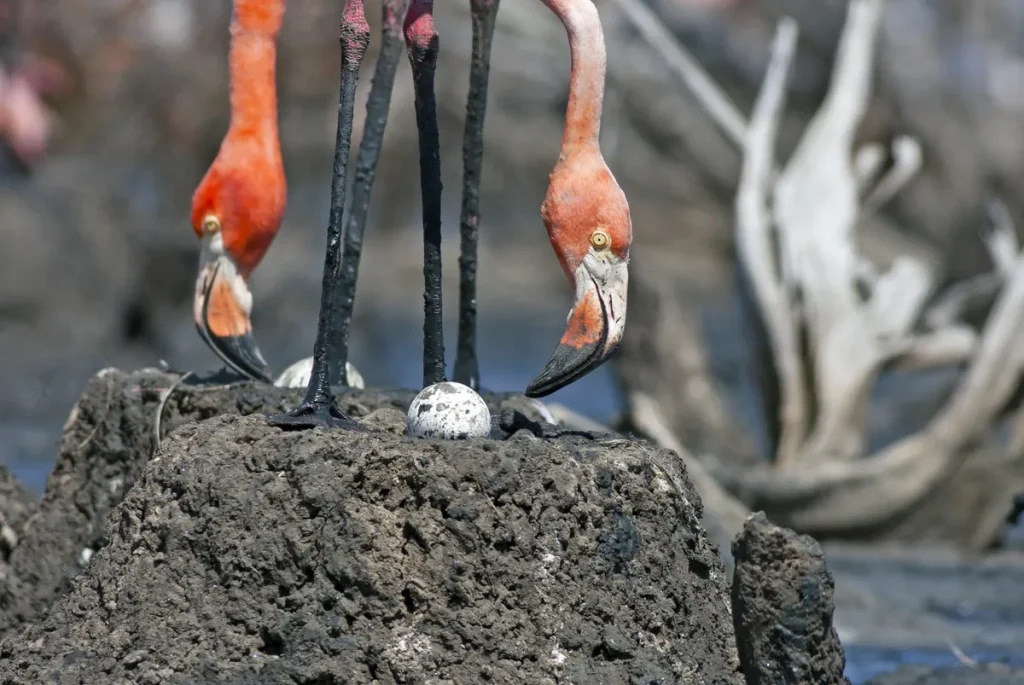
Flamingo nesting is a well-organized and communal activity that often takes place in large, noisy colonies. Flamingos build nest mounds out of mud, stones, and feathers. These nests are about 12 inches high and protect the single egg from heat and flooding. Each pair typically lays one egg, and both parents share incubation duties.
After about 27-31 days of incubation, the egg hatches into a chick, which is fed crop milk by both parents. These nesting sites are often reused annually and can contain thousands of individual nests in close proximity. The synchronized timing of breeding across the colony helps ensure that chicks grow at the same rate and enter crèches together.
Flamingo nesting is heavily influenced by environmental conditions. Adequate water levels and food availability are critical for successful nesting. In some regions, such as Lake Natron in Tanzania, entire nesting events can fail if the water becomes too high or low. This highlights the importance of habitat preservation and monitoring by conservation groups.
| Aspect | Description |
| Nest Material | Mud, stones, feathers |
| Nest Shape | Cone/mound, ~12 inches tall |
| Eggs Laid | Typically 1 per pair |
| Incubation Period | 27–31 days |
| Parental Involvement | Both parents incubate and feed chick |
| Threats | Flooding, predation, human disruption |
Greater Flamingo Facts: Meet the Largest Flamingo Species
The Greater Flamingo (Phoenicopterus roseus) is the most widespread and largest of all flamingo species. Found in parts of Africa, southern Europe, the Indian subcontinent, and the Middle East, these birds thrive in saline or alkaline lakes, coastal mudflats, and lagoons. One of the most interesting greater flamingo facts is that they can reach a height of 4.7 feet with a wingspan of 4.9 to 5.6 feet. Their coloration is typically paler pink compared to their Caribbean or American cousins, and they often have black-tipped wings and a pinkish bill with a black tip.
Greater Flamingos are highly social and are often seen in colonies that number in the thousands. Their diet consists mainly of crustaceans, mollusks, and blue-green algae, which contribute to their coloration. As filter feeders, they stir up the muddy lake beds with their feet and use their specialized beaks to trap food particles. This species is known for its elegant and synchronized group dances during mating season. While generally not endangered, the species faces habitat threats due to water pollution and tourism-related disturbances.
| Feature | Greater Flamingo Details |
|---|---|
| Scientific Name | Phoenicopterus roseus |
| Average Height | 3.9–4.7 feet |
| Wingspan | 4.9–5.6 feet |
| Habitat | Africa, India, Middle East, southern Europe |
| Diet | Algae, crustaceans, mollusks |
| Conservation Status | Least Concern (IUCN) |
| Unique Trait | Largest and most widely spread species |
Lesser Flamingo Facts: The Smallest and Rarest
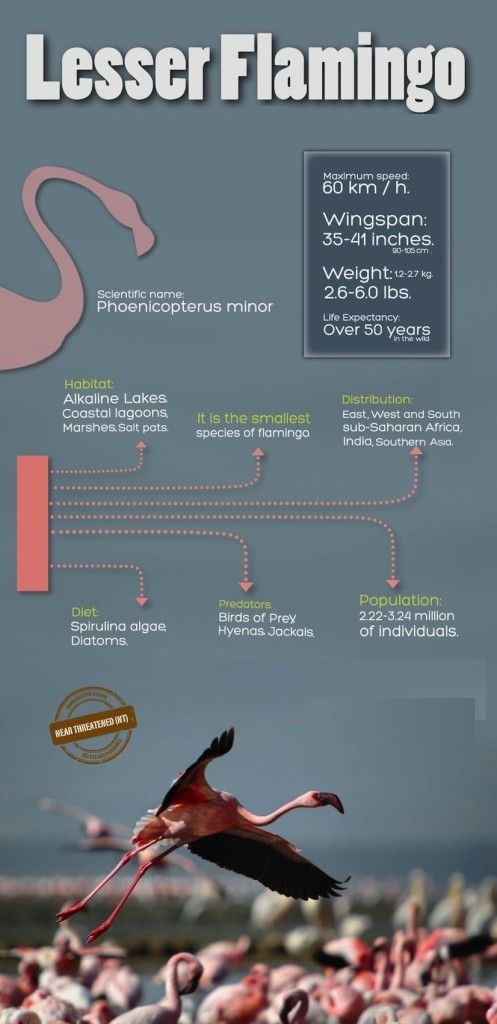
The Lesser Flamingo (Phoeniconaias minor) is the smallest and most numerous of all flamingo species. They are primarily found in sub-Saharan Africa and parts of India, with large populations around alkaline lakes such as Lake Natron and Lake Bogoria. One of the most striking lesser flamingo facts is their vibrant deep pink coloration, more pronounced than the Greater Flamingo, due to a diet rich in spirulina algae.
Despite their numbers, they are classified as “Near Threatened” due to their limited breeding sites and vulnerability to environmental changes. Their highly specialized feeding technique involves filtering tiny algae and diatoms using comb-like lamellae in their bills. They also engage in mass courtship displays that involve synchronized head-flagging and wing-saluting.
Conservation efforts are crucial for their survival, especially at their key breeding sites. Flamingo land facts often include the importance of alkaline lake conservation, as these ecosystems support their breeding and feeding needs. With increasing industrial and tourism pressures, preserving their habitat has become a key focus for organizations like WWF.
| Feature | Lesser Flamingo Details |
| Scientific Name | Phoeniconaias minor |
| Average Height | 2.6–3 feet |
| Coloration | Bright pink |
| Primary Habitat | Alkaline lakes in Africa, India |
| Diet | Spirulina algae, diatoms |
| Conservation Status | Near Threatened |
| Notable Fact | Most abundant flamingo species |
American Flamingo Facts: The Caribbean Beauty
The American Flamingo (Phoenicopterus ruber) is known for its vibrant reddish-pink plumage and is found mainly in the Caribbean, northern South America, and parts of Florida and the Galápagos Islands. These flamingos are often showcased in zoos and wildlife documentaries because of their striking appearance and social behaviors. American flamingo facts also highlight that this species is the most colorful among flamingos, thanks to its carotenoid-rich diet of algae and small crustaceans.
Their habitats include shallow coastal lagoons, mudflats, and salt flats, where they form large, noisy colonies. American flamingos engage in elaborate group courtship displays involving synchronized walking, head-flagging, and wing displays. They nest in mud mounds and usually lay a single egg. These birds have excellent vocal communication, which is used to maintain group cohesion and interact with chicks.
Conservation efforts focus on protecting their breeding sites, particularly in places like the Bahamas and Bonaire. The species is listed as Least Concern but remains vulnerable to habitat loss and pollution. Their vivid color and graceful posture make them an enduring symbol of tropical beauty and conservation education.
| Feature | American Flamingo Details |
|---|---|
| Scientific Name | Phoenicopterus ruber |
| Primary Habitat | Caribbean, South America, Galápagos |
| Coloration | Bright red-pink |
| Nesting | Mud mound, 1 egg |
| Conservation Status | Least Concern (IUCN) |
| Notable Fact | Most vibrant flamingo species |
Chilean Flamingo Facts: South America’s Shy Wader
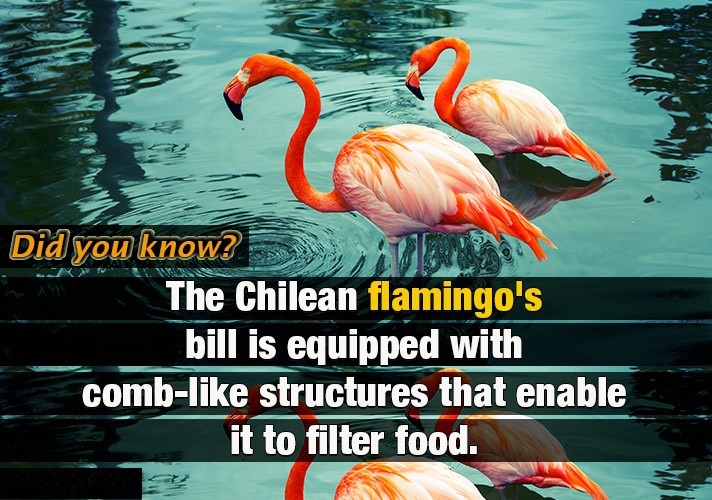
The Chilean Flamingo (Phoenicopterus chilensis) is native to South America and is found in countries such as Chile, Argentina, Bolivia, and southern Brazil. This species is slightly smaller than the Greater Flamingo and is identified by its light pink body, grayish legs with pink joints, and a black-tipped beak. One of the notable Chilean flamingo facts is that they are well-adapted to cold, high-altitude salt lakes.
These birds form smaller colonies compared to their African and Caribbean counterparts but maintain the same social nature. They feed on algae, diatoms, and tiny aquatic invertebrates through filter-feeding. The Chilean Flamingo is listed as Near Threatened due to wetland degradation, water extraction, and climate change impacting their habitats.
They are commonly seen in wildlife reserves and zoos around the world and play an educational role in flamingo conservation. In South America, they are a vital part of the ecosystem, contributing to the balance of aquatic habitats. Efforts by environmental agencies and organizations like the WWF are helping protect their breeding grounds and migratory paths.
| Feature | Chilean Flamingo Details |
| Scientific Name | Phoenicopterus chilensis |
| Average Height | 3.3–4.3 feet |
| Habitat | South American salt lakes |
| Coloration | Pale pink with gray legs, pink joints |
| Diet | Algae, diatoms, invertebrates |
| Conservation Status | Near Threatened |
| Unique Adaptation | Tolerance for high-altitude cold habitats |
Andean Flamingo Facts: High Altitude Marvel
The Andean Flamingo (Phoenicoparrus andinus) is one of the rarest flamingo species and is mostly found in the high-altitude salt flats and alkaline lakes of the Andes Mountains in South America. Native to countries like Argentina, Bolivia, Chile, and Peru, this species is specially adapted to extreme environments that are high in salinity and elevation.
Andean flamingo facts include their distinctive features such as pale pink plumage, yellow legs, and a black-tipped bill. Unlike other flamingos, they have three toes instead of the usual four. They rely on a specialized diet of diatoms and microscopic algae and use their deep, curved beaks for filter feeding.
Due to habitat loss and mining activities, their population is in decline and they are classified as Vulnerable by the IUCN. Conservation organizations, including the WWF and Flamingo Specialist Group, monitor breeding grounds and migration routes to ensure protection. Andean Flamingos are a symbol of ecological richness in the harshest of landscapes and are increasingly featured in flamingo facts for kids and awareness campaigns.
| Feature | Andean Flamingo Details |
|---|---|
| Scientific Name | Phoenicoparrus andinus |
| Habitat | Andes Mountains (South America) |
| Unique Features | Yellow legs, black-tipped bill, 3 toes |
| Diet | Diatoms, algae |
| Conservation Status | Vulnerable (IUCN) |
| Adaptation | Tolerance to extreme altitude and salinity |
James’s Flamingo Facts: The Puna Specialist
James’s Flamingo (Phoenicoparrus jamesi), also known as the Puna Flamingo, is a small and rare species of flamingo found in the high altitudes of the Andean plateaus of Peru, Chile, Bolivia, and Argentina. They are closely related to the Andean Flamingo but are even smaller in size, with delicate light pink plumage and bright red backs.
One of the most fascinating James’s flamingo facts is their specialized bill that allows them to filter very fine particles from the water, feeding mainly on microscopic diatoms. These flamingos have striking yellow legs and a reddish-black bill tip. They breed in remote, high-elevation salt flats and shallow lakes, forming nesting colonies during the summer.
James’s Flamingo is listed as Near Threatened due to climate variability, mining, and water pollution. Conservation programs led by organizations like the National Zoo (Smithsonian) and local wildlife trusts work to protect this elusive species and its habitat. Often featured in educational material and flamingo facts for kids printable resources, James’s Flamingo highlights the importance of biodiversity in South America’s mountainous regions.
| Feature | James’s Flamingo Details |
| Scientific Name | Phoenicoparrus jamesi |
| Habitat | Altiplano (Andean highlands) |
| Coloration | Light pink with red back |
| Diet | Microscopic diatoms |
| Conservation Status | Near Threatened |
| Unique Trait | Filters ultra-fine food particles |
Caribbean Flamingo Facts: Vibrant Dwellers of the Tropics
The Caribbean flamingo, often referred to as the American flamingo (Phoenicopterus ruber), is most commonly found in the Caribbean islands, particularly the Bahamas, Cuba, and coastal regions of Mexico. These birds are renowned for their intense pink or reddish plumage—the brightest among all flamingo species—thanks to their carotenoid-rich diet composed of algae, small crustaceans, and plankton.
These birds often feature in flamingo facts for kids and preschoolers due to their bright coloration and iconic stance of standing on one leg. The Caribbean flamingo has an average height of 1.2 to 1.4 meters and weighs around 2.5 to 3.5 kg. Their colonies can be massive, sometimes exceeding thousands of birds, making their synchronized displays a marvel of the natural world.
Caribbean flamingo facts are frequently used in educational settings, including flamingo facts in Hindi for diverse audiences and printable materials. Due to conservation efforts by organizations like SeaWorld and National Geographic Kids, their numbers have stabilized in many areas. Still, habitat degradation and tourism pressure continue to pose threats.
| Feature | Caribbean Flamingo Details |
|---|---|
| Scientific Name | Phoenicopterus ruber |
| Habitat | Caribbean islands, Mexico |
| Coloration | Bright pink to red |
| Diet | Algae, crustaceans, plankton |
| Conservation Status | Least Concern |
| Educational Use | Popular in kids’ books and zoo exhibits |
Flamingo Standing on One Leg: A Balance Mystery
One of the most iconic and puzzling behaviors of flamingos is their tendency to stand on one leg. This behavior, often showcased in fun flamingo facts and flamingo facts for children, has fascinated researchers for decades. Contrary to earlier beliefs that it was merely a resting posture, studies suggest this one-legged stance helps flamingos conserve body heat and maintain muscular balance with minimal effort.
When flamingos stand on one leg, their body weight is distributed in a way that requires less muscular effort. This position is so stable that they can even sleep in it. It’s a topic of interest not just in biology but also in physics and biomechanics. The leg tucked up against their body reduces heat loss in cold water, which is crucial given their often chilly and wet habitats like alkaline lakes.
This behavior is frequently used in flamingo facts for preschoolers and kids’ printable materials. It’s also a hot topic on social media, with flamingo facts Twitter threads regularly exploring this mystery. The posture has even found symbolic meaning, representing balance and poise in spiritual and cultural contexts.
| Feature | Description |
|---|---|
| Common Behavior | Standing on one leg |
| Purpose | Heat conservation, muscle rest |
| Relevance | Flamingo love facts, symbolism |
| Occurrence | Frequent during sleep and rest |
| Educational Use | Kids’ materials, preschool resources |
Flamingo Conservation: Protecting the Pink Wonders
Flamingos are facing various threats due to habitat loss, climate change, and human interference. Conservation efforts are crucial to preserving their populations. Organizations like WWF, National Geographic Kids, and the San Diego Zoo have been actively involved in flamingo protection and research, focusing on habitat restoration and awareness campaigns.
Flamingo conservation also highlights the importance of preserving alkaline lakes, saline lagoons, and other specialized ecosystems that flamingos call home. With the increasing threat of global warming, many flamingo species are moving to new habitats, which can disrupt their breeding cycles and social structures. Conservationists are also focusing on monitoring migration patterns to prevent accidental harm during their long-distance journeys.
Flamingo conservation facts are often featured in various resources, including flamingo facts for kids and printable educational material. These efforts aim to ensure that future generations can continue to appreciate the beauty and ecological importance of these elegant birds.
| Threats | Conservation Measures |
|---|---|
| Habitat destruction | Protected areas and habitat restoration |
| Climate change | Monitoring migration and breeding behaviors |
| Pollution and tourism | Eco-tourism initiatives and education |
| Illegal hunting | Legal protection and international agreements |
| Conservation efforts | WWF, San Diego Zoo, National Geographic |
Flamingo Migration: Journey Across Continents
Flamingos are known for their impressive migratory journeys. Some species, like the Greater Flamingo and the Lesser Flamingo, migrate long distances between breeding and feeding grounds. These migrations often occur over several hundred kilometers and can span across countries and continents. Flamingos typically migrate to find suitable food sources, and their journeys can span vast areas of Africa, Asia, and the Americas.
Flamingo migration is guided by seasonal shifts, as flamingos move to areas with warmer temperatures and more abundant food during the colder months. Their migration is also crucial for ensuring that they can breed in optimal conditions. Flamingo migration facts are often included in flamingo facts for kids videos and educational content to illustrate the birds’ incredible adaptability.
Research on flamingo migration has been conducted by wildlife organizations and has led to a greater understanding of the species’ behaviors. In particular, flamingo migration patterns are studied to assess the impact of climate change and how shifting environmental conditions affect their migratory routes and breeding success.
| Migration Pattern | Description |
|---|---|
| Distance traveled | Hundreds of kilometers, across countries |
| Reasons for migration | Food availability, breeding conditions |
| Common migratory species | Greater Flamingo, Lesser Flamingo |
| Seasonal migration | Occurs primarily during winter and spring |
| Educational Use | Featured in documentaries and children’s resources |
Flamingo Species: Diversity in the Flamingo Family
The flamingo family is diverse, with six main species scattered across different regions of the world. These species vary in size, coloration, and behavior but share common characteristics such as their long legs, unique bills, and pink to reddish plumage. The six main flamingo species are the Greater Flamingo, Lesser Flamingo, American Flamingo, Chilean Flamingo, Andean Flamingo, and James’s Flamingo.
Each species is adapted to its specific habitat, from the high-altitude regions of the Andes to the tropical wetlands of the Caribbean. The American Flamingo, for instance, is commonly found in the Caribbean, while the Andean Flamingo resides in high-altitude lakes. Flamingo species are often distinguished by slight variations in size, color, and their ability to tolerate different environmental conditions, such as salinity and temperature.
These species are crucial in maintaining the balance of their ecosystems, as their filter-feeding habits help regulate populations of algae and small invertebrates. Flamingo facts, including facts about each species, are regularly shared in educational platforms, including flamingo facts for kids and printable games.
| Flamingo Species | Habitat |
|---|---|
| Greater Flamingo | Coastal wetlands, saline lakes |
| Lesser Flamingo | Alkaline lakes, saline lagoons |
| American Flamingo | Caribbean, coastal areas |
| Chilean Flamingo | South American wetlands |
| Andean Flamingo | High-altitude lakes in South America |
| James’s Flamingo | Puna region, Andean mountains |
Flamingo Lifespan: How Long Do Flamingos Live?
Flamingos are known for their longevity. On average, they live between 20 and 30 years in the wild, with some individuals reaching over 40 years of age. Their lifespan is influenced by factors such as diet, habitat conditions, and the presence of predators. In captivity, where they are protected from threats and provided with optimal conditions, flamingos can live even longer, sometimes exceeding 50 years.
The flamingo’s long lifespan is an indicator of their ability to adapt and thrive in challenging environments. However, their survival is still at risk due to external threats like pollution and climate change. Understanding the factors that affect the flamingo’s lifespan can help in the development of effective conservation strategies.
Flamingo lifespan facts are often used in educational materials aimed at kids, including flamingo facts for children and printable quizzes that test knowledge about flamingo biology.
| Age Range | Lifespan Information |
|---|---|
| In the wild | 20-30 years |
| In captivity | Can exceed 50 years |
| Factors affecting lifespan | Diet, habitat quality, protection from threats |
| Conservation relevance | Helps to understand population sustainability |
10 FUN FACTS About FLAMINGOS
Flamingo Behavior: Social and Unique
Flamingos are highly social birds that thrive in large colonies, which can consist of thousands of individuals. Their behavior is centered around the flock, and their activities often involve synchronized movements and interactions. They engage in communal foraging, nesting, and even synchronized displays during courtship. This social behavior provides benefits such as protection from predators and more efficient feeding in dense groups.
Interestingly, flamingos have been observed engaging in a variety of behaviors that are crucial for their survival. These include preening each other’s feathers to maintain their plumage, as well as engaging in synchronized “dancing” during the mating season to attract potential mates. Flamingo facts related to their social nature are often discussed in educational resources, such as flamingo facts for preschoolers and other materials for young children.
The cooperative nature of flamingos helps them thrive in challenging environments, where survival depends on both individual and collective efforts.
| Social Behavior | Description |
|---|---|
| Colony size | Can range from hundreds to thousands |
| Synchronized movements | Important for courtship and feeding |
| Preening | Flamingos clean each other’s feathers |
| Mating dance | Courtship behavior involving synchronized actions |
| Survival advantage | Protection from predators and social learning |
Flamingo Filter Feeding: How Do Flamingos Eat?
Flamingos are filter feeders, which means they use their specialized bills to sift through water in search of food. Their bills have lamellae, comb-like structures that help them filter out small organisms like algae, crustaceans, and plankton. Flamingos feed by dipping their heads into the water, turning their bills upside down, and stirring the water to trap food particles.
Their filter-feeding process is unique to flamingos and a few other bird species, such as the black-necked stilt. The ability to feed on small particles in large quantities is a critical adaptation that allows flamingos to thrive in environments where food availability can vary. In fact, flamingos are often found in saline or alkaline environments where other birds would struggle to survive.
Flamingo filter feeding is a fascinating process that is often explained in educational content, including flamingo facts for kids and printable activity sheets, which make learning about these amazing birds accessible to younger audiences.
| Feeding Mechanism | Description |
|---|---|
| Filter feeding | Using lamellae in the bill to sift out food |
| Food sources | Algae, crustaceans, plankton |
| Feeding environment | Saline lagoons, alkaline lakes |
| Adaptation | Helps survive in harsh environments |
| Educational Resources | Kids’ videos and printable worksheets |
Flamingo Tongue Snail Fun Facts
One of the lesser-known yet fascinating aspects of flamingo biology is their relationship with the tongue snail. These snails live on the flamingos’ bills and feed on algae. This unique partnership benefits both parties: the snails get a reliable food source, and the flamingos may benefit from a cleaner bill.
This mutualistic relationship is a great example of the interconnectedness of species in an ecosystem. Flamingo tongue snails can be a topic of interest for children when learning flamingo facts in a fun and interactive way, making it easier to understand the importance of symbiotic relationships in nature.
Flamingo tongue snails are a wonderful addition to flamingo facts for kids, especially those interested in how animals depend on one another to thrive in challenging environments.
| Species | Flamingo Tongue Snail |
|---|---|
| Symbiotic relationship | Snails live on flamingo bills |
| Food source | Algae on the flamingo’s bill |
| Benefit to flamingo | Cleaner bills and reduced parasites |
| Educational use | Featured in fun flamingo facts and videos |
Flamingo Symbolism: What Does the Flamingo Represent?
Flamingos hold symbolic significance in various cultures around the world. They are often associated with beauty, balance, and grace due to their elegant posture and striking appearance. In some cultures, flamingos symbolize love and fertility, as seen in their elaborate courtship dances and monogamous behavior.
In spiritual contexts, the flamingo is considered a symbol of transformation and spiritual growth. Its ability to thrive in challenging conditions, such as harsh habitats and difficult migration patterns, represents resilience and adaptability. Flamingo symbolism is often featured in cultural discussions, art, and literature, where they are used to represent grace, beauty, and inner strength.
These symbolic meanings make flamingos an interesting subject for both spiritual exploration and cultural appreciation, and they often appear in discussions of flamingo facts in Hindi and other international contexts.
| Symbolism | Representation |
|---|---|
| Beauty and grace | Flamingos are admired for their elegant appearance |
| Love and fertility | Reflected in mating dances and monogamy |
| Transformation | Spiritual growth, resilience, and adaptability |
| Cultural presence | Featured in art, literature, and spiritual beliefs |
Flamingo Conservation Organizations: Who Is Protecting Flamingos?
Several organizations are dedicated to flamingo conservation and ensuring the survival of these iconic birds. WWF (World Wildlife Fund), National Geographic, SeaWorld, and the San Diego Zoo all play pivotal roles in studying, protecting, and promoting flamingo awareness. These organizations focus on habitat protection, research on migration patterns, and breeding programs for endangered species like the Lesser Flamingo and Andean Flamingo.
Additionally, these groups offer educational resources, including flamingo facts for children, to raise awareness about the importance of preserving flamingo populations. They collaborate with local communities, governments, and other stakeholders to address the threats faced by flamingos, such as habitat destruction, poaching, and climate change.
Flamingo facts, including information on conservation efforts, are regularly shared by these organizations to inspire individuals and communities to take action and protect flamingos for future generations.
| Organization | Role in Flamingo Conservation |
|---|---|
| WWF | Habitat protection, research, and advocacy |
| National Geographic | Education and awareness campaigns |
| SeaWorld | Breeding programs and species monitoring |
| San Diego Zoo | Conservation research and flamingo care |
| Educational outreach | Kids’ educational resources and public programs |
Flamingo Fun Facts: Amazing Flamingo Trivia
Flamingos are truly fascinating creatures, and there are countless fun flamingo facts that surprise and delight people of all ages. From their ability to stand on one leg to their vibrant pink feathers, flamingos have a variety of unique traits. Here are a few fun flamingo facts to wrap up our exploration of this incredible bird:
- Flamingos are born gray, and they turn pink as they mature.
- They can sleep while standing on one leg.
- Flamingos have been known to live over 50 years in captivity.
- The word “flamingo” comes from the Spanish or Portuguese word for “flame,” due to their bright color.
- A group of flamingos is called a “flamboyance.”
These fun facts about flamingos are often shared in children’s books, videos, and educational programs. They provide an entertaining and informative way to engage young audiences in learning about wildlife and conservation.
| Fun Fact | Description |
|---|---|
| Flamingos are born gray | Their feathers turn pink as they age |
| They can sleep on one leg | Helps conserve body heat and energy |
| Long lifespan | Over 50 years in some cases |
| Name origin | From Spanish or Portuguese for “flame” |
| Group name | A group of flamingos is called a “flamboyance” |
FAQs on Flamingo Facts:
1. Why are flamingos pink?
Answer: Flamingos are pink because of the carotenoid pigments found in their diet, which includes algae, shrimp, and crustaceans. These pigments are broken down in the liver and deposited in the skin and feathers, giving flamingos their famous pink hue.
2. What is the lifespan of a flamingo?
Answer: Flamingos can live for 20 to 30 years in the wild and even longer—up to 50 years in captivity—when cared for properly in zoos and wildlife sanctuaries.
3. How many species of flamingos are there?
Answer: There are six species of flamingos:
- Greater Flamingo
- Lesser Flamingo
- American Flamingo
- Chilean Flamingo
- Andean Flamingo
- James’s Flamingo
Each species has unique traits, habitats, and coloration patterns.
4. Where do flamingos build their nests?
Answer: Flamingos build cone-shaped mud nests near shallow water bodies like saline lakes and lagoons. These nests protect the eggs from flooding and predators.
5. Do flamingos migrate?
Answer: Yes, flamingos migrate seasonally, especially when their food sources or water levels become insufficient. Some species travel hundreds of miles overnight to find better habitats.
6. How do flamingos communicate?
Answer: Flamingos use a variety of vocalizations, including honking, growling, and grunting, along with body language like head-flagging or wing-saluting to communicate within their colonies.
7. Can flamingos fly?
Answer: Yes, flamingos are strong fliers. They can fly at speeds of up to 35 miles per hour (56 km/h) and often travel in large V-shaped flocks over long distances.
8. Why do flamingos often stand on one leg?
Answer: Flamingos stand on one leg to regulate body temperature and reduce muscle fatigue. This posture helps them conserve energy, especially when standing in cold water for extended periods.
9. What do flamingo chicks look like?
Answer: Flamingo chicks are born grey or white and are covered in fluffy down feathers. They are fed a nutrient-rich secretion called crop milk by both parents until they can feed themselves.
10. Are flamingos social animals?
Answer: Absolutely! Flamingos are extremely social birds and live in large colonies that can include thousands of individuals. These groups help with protection, synchronized mating, and raising chicks.
Explore more fun facts about birds and animals by visiting: WhatIsTheSpecialtyOf
